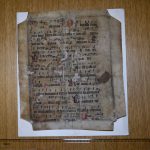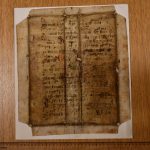The detached fragment is a complete folio from an antiphoner containing a part of the office from the feast of the Annunciation of Mary: the second and third nocturnes of the Matins. The fragment was written with German Gothic notation (see below for analysis). The so-called Hufnagelschrift was the notation type of the Low Countries and the narrower Rhineland in the Middle Ages. Initially used as an adiastematic neume notation, it was adapted to the staff system by local reformed workshops in the 12th century, which worked according to the principles of Guido Arezzo, creating one of the most advanced notational systems of the period. The Hufnagelnotation mixed German and Messine neume forms and was characterized primarily by the horseshoe-shaped virga (as syllabic basic neume) and the round form of the clivis. The early version is recognizable for its thin, curved, rounded forms, which later became more rigid, regular and angular as gothic pen treatment spread and the size of the codices increased. The notation originated in the area around Liège, Köln, Utrecht and Münster, from where it spread southwards along the Rhine and then into Eastern Europe, mainly through the expansion of the Teutonic Knights: by the 15th century it was already widely used. This makes it difficult to determine the provenance of its sources only on the basis of musical notation, particularly in the case of the fragments written in the 14th and 15th centuries, where great emphasis must therefore be placed on the liturgical content and the melodic variants.
In the medieval Kingdom of Hungary, German Gothic notation was not used in professional scriptoria, with the occasional exception of the Missal from Csukárd (Csukárd, a village in Pozsony / Bratislava County), in which the scribe, the local parish priest Henricus, was of Westphalian origin, i.e. of foreign education (Alba Iulia, Batthyaneum, MS. II. 134, available on manuscriptorium:
https://www.manuscriptorium.com/apps/index.php?direct=record&pid=NLR___-NLORB_MS_II_134___0PHLPN4-ro; for description and content see: https://usuarium.elte.hu/book/1190/view.) This source does not testify to the general writing practice of this type of notation in medieval Hungary. In the case of codex fragments preserving German Gothic notation, we must therefore always assume a foreign parent codex – from the Low Countries, Germany, Poland –, the Hungarian origin can be ruled out.
The parchment in question is almost complete, with only the four corners cut off. The ink on the outer, verso side has been worn away by centuries of use as a cover, but the inner side is intact and provides a reference point for examination. Under the signature R 492, the library holds a catalog of goods and acquisitions of the College of Debrecen, recorded between 1691 and 1706. Amongst others, the diary records the donations of foundations established for the maintenance of the school, including the donation of Mihály Apafi, which is also referred to as a curiosity in the description of the old catalog of the library. In 1667, the Transylvanian prince Mihály Apafi established a foundation for the maintenance of the Debrecen school: “Given the depleted condition of our Debrecen College, which has been abandoned by its patrons due to many wars and the many disasters of the homeland, we have, out of our duty, and in consideration of the divine need for it, ordered 2000 dose salt each year to be given from our mine in Dézs.” (See István Gazdag, “Debrecen Foundations before the First World War”, Yearbook of the Archives of the County of Hajdú-Bihar, XIV/8, 80.) The donations were varied, like Mihály Apafi, many donated to feed the students, and others wanted to help the activities of the college choir “Kántus”.
We don’t know exactly when the register was bound – whether it was written in a bound notebook or whether it was only later that the diary was protected by a parchment cover. The places and folds of wear on the fragment show that the volume had an unusually long shape, and the spine suggests that it must have been quite bulky. Why the catalog was bound in a foreign fragment will be discussed below, when determining provenance.
Chants of the Office of Annuntiation of Mary (March 25) can be identified on the fragments, antiphons and responsories for the Matins written throughout, revealing a complete cycle of proper chants. The selection of responsories is less helpful in identifying the provenance of the fragment. More telling is the antiphon series of the third nocturn. It is not the chants themselves that are remarkable, since they are three common antiphons (Missus est Gabriel, Ave Maria, Benedicta tu), but their order. The 8th-mode Missus est Gabriel angelus (not to be confused with the 1st-mode antiphon of its text variant, see Cantus Index 003793) appears in various hours in the different liturgies, usually in the Lauds or Vespers of the feast, possibly as an alternative surplus antiphon, and rarely as the first antiphon at the top of Matins. Despite the highly variable position, the beginning of the third nocturn is registered in the Cantus Index from only two sources: the early 16th-century antiphoner of the canonical monastery of St Vitus of Hilwartshausen in Lower Saxony and the antiphoner of the Marienkerk in Utrecht (Ms 406 in the University Library in Utrecht). The celebration of the Annuntiation in the 12th century rarely consisted of a complete, elaborate chant series (commune chnts are included instead), so the solution of the early Utrecht source is remarkable (perhaps also associated with the title of Mary of the church).
With all this in mind, we have compared the musical notation of the fragment with the available rich manuscript material from Utrecht. These codices (antiphoners and a notated breviary) are also available online: https://utrechtuniversity.on.worldcat.org/discovery?lang=en. The fragment contains 12 lines with music and texts, i.e. the layout is quite dense and compact. The staves are formed by four black lines, with a c at the beginning of each line and a dot marking the f, from which a run-off line starts at the bottom right. The end of each line is marked by a custos in the shape of a pipe. There are no dividing “bar lines” on the staves at all, which is a characteristic of Utrecht notation. The arrangement is therefore perfectly in keeping with Utrecht practice. The notation on the fragment is cursive and practical in character, the copyist writing quickly and spontaneously, in a casual manner. This can also be partly explained by the chronology, i.e. Hufnagelnotation evolved in the 14th century from the round and regular forms of the 12th and 13th centuries into cursive shorthand and only later became a representative codex notation. The stage shown on the fragment (already with custos) dates from the first half of the 15th century. The source may be linked to one of the four university churches of Utrecht (churches of St Mary, St Salvator, St John, St Peter).
As far as the neume set and structures are concerned, there is a perfect overlap with the Utrecht practice: the Gothic Messine fly’s foot punctum is accompanied by the horseshoe-shaped virga: these are the basic neumes indicating one note. The German rounded clivis, broken in Gothic technique and ending in a rhombus with a long introductory line, is also characteristic, as is the spur pes with its curved first element. The Utrecht micro-tone markings discovered by Ike de Loos and studied by L. A. J. Lousberg (https://dspace.library.uu.nl/handle/1874/369247) are no longer discernible in the writing and have faded over time.
The paleographic and melodic analysis of the Debrecen fragment and the Utrecht sources are particularly impressive, especially if we compare the fragment to the 12th, 14th and 15th century Utrecht codices one by one. The chants are identical from note to note, but it is also clear how the neume set was simplified, and how the archaic signs of the notation gradually disappeared until the 15th century. The Debrecen fragment, however, still preserves some old neumes, such as the quilisma, which starts with two “loops”. In the latest source (Hs. 404) https://objects.library.uu.nl/reader/index.php?obj=1874-333897&lan=en#page//16/99/04/169904414817365730174730857497382141164.jpg/mode/1up) it has been simplified to a simple pes. A compromise can be seen, for example, in the neume above the first syllable of the responsory Dabit illi Dominus: the fragment tries to follow faithfully the 12th-century codex (Hs. 406), but later the quilisma and cephalicus of the beginning of the verse Et regnabit disappear. The notation of the representative 15th-century Utrecht notated breviary is devoid of any particularity: there is no trace of quilisma, no postpunctums, no strophicus-franculus.
Returning to the question of liturgical content, there is a chant assignation that could only be explained after the chronologically extended analysis. Indeed, the second responsory of the third nocturn is Quomodo fiet istud and not Christi virgo dilectissima, which appears in the Utrecht codices of the 12th–14th centuries (Hs. 406, f. 61v, Hs. 407, f. 235r, i.e. the early sources choose Quomodo fiet as the last responsory of Matins). The 15th-century breviarium notatum (Hs. 404, 248r), however, shows the order of the Debrecen fragment, i.e. at this point the Utrecht tradition itself was modified, and this late solution was also chosen by the parent codex of the fragment.
The order of the chants of the Annuntiatio, which does not usually record proper items, has on the whole settled the question of provenance: the assignment of the liturgical position of the chants is so specific that it reveals a narrower provenance.
The only question remains the identical use of the antiphoner of the Lower Saxon canons, a very distant occurrence of the same chant assignation. The Hilwartshausen canonries were under the jurisdiction of Mainz, at a considerable distance from Utrecht. Is it possible that our fragment is also more closely related to this area? The results of the melodic analysis did not support this. On the one hand, the comparative analysis showed that the melodies of the Utrecht sources and the Debrecen fragment followed a chant tradition belonging to the pentatonic dialect area – the characteristic points favor the turns of minor thirds – while in the antiphoner of the Augustinian canonesses, diatonic turns are prescribed at the same points. On the other hand, the melodic micro-variation between Utrecht and the canonical antiphoner is much more significant than between Utrecht and the Debrecen fragment, the latter two being almost identical note for note, which is evidence of the closest connection. Not to mention the differences in the Hufnagelnotation: the canonesses draw more from the Messine tradition than Utrecht, the Messine clivis of 7-shape is common, while the Utrecht sources use only the Gothic version of the round clivis. Despite the undoubted liturgical parallels, the differences in melody and notation suggest a more distant connection in the case of the canonical antiphoner, while at the same time confirming the close relationship between the Debrecen fragment and the Utrecht codices.
The peregrinations of Hungarian students to the Utrecht university may explain how a piece of a liturgical music codex from Utrecht was used as a cover for the Debrecen school catalog. Many students visited Utrecht, and many of those who visited the university were from Debrecen (cf. Album studiosorum Academiae Rheno-Traiectinae 1636-1886, Ultraiecti: J. L. Beijers – J. van Boekhoven, 1886, online: (https://books.google.hu/books? id=1jABAAAAAAAAYAAJ&printsec=frontcover&source=gbs_atb&redir_esc=y#v=onepage&q&f=false). Through his studies there, one of the students may have come into possession of the old, obsolete codex or codex leaf and brought it home to Debrecen, where it was later used as a binding material.
Gabriella Gilányi



